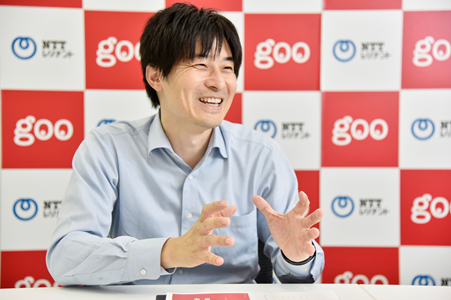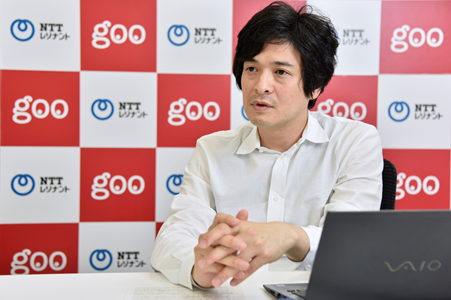Key points of this case study
- A total of 128GB of memory enables parallel verification
- Build an environment in a short time using NGC containers
- Expectations for new NVIDIA products that improve performance every year
Customers interviewed this time
NTT Resonant Corporation
NTT Resonant has developed a chatbot that realizes natural Japanese dialogue through deep learning that utilizes the vast amount of data accumulated on the portal sites "goo" and "Tell me!goo." The company has been developing BtoC services one after another using AI, such as “AI Osiel” that provides love consultations and “Travel AI” that creates travel plans, and has received high praise.
The bottleneck in AI development was the time it takes to learn deep learning. greatly improved speed. It is now possible to develop more advanced services using AI.
Company HP: https://www.nttr.co.jp/
In 2018, NTT Resonant released “goo AI x DESIGN,” which provides AI utilization know-how and technology as a corporate solution. With goo AI x DESIGN, it is possible to build a close relationship with fans by creating channels and promoting with character AI, realizing engagement with users, realizing drama characters with AI. A service that allows you to talk with drama characters such as "AI Kahoko" and "AI Nana-chan" in collaboration with Nippon TV has been released and has attracted a lot of attention.
NTT Resonant's AI business accelerated by NVIDIA DGX-1
Recently, NTT Resonant is also developing a B2B service that provides AI solutions to companies that want to utilize AI. NTT Resonant specializes in chatbots that enable natural Japanese dialogue. "NVIDIA DGX-1" is indispensable for the company's AI development.
challenge
NTT Resonant started operating the Internet portal site “goo” in March 1997, and this year (2019) is the 23rd year. Since its opening, many people have used it, and a large number of questions and answers have been received on the Q&A site "Oshiete! goo." NTT Resonant has accumulated a huge amount of Japanese notation data such as search logs and Q&A data by operating goo and tell me! goo for many years. Long before deep learning was in the spotlight, machine learning was used to analyze huge amounts of data, and it has realized advanced search functions, support for spelling variations, and various dictionary functions.
In recent years, NTT Resonant has been particularly focusing on AI technology such as deep learning. A deep learning model has a large number of weight parameters inside, so a large amount of high-quality training data is required to derive the optimum weight. Therefore, NTT Resonant started research and development of AI using its own vast amount of data. The first service that was born from this result is “AI Osiel”, which started operation in September 2016.
AI Osiel is a service in which AI provides advice for love consultation, and when the consulter writes the consultation, it immediately provides an accurate answer. This response consists of four elements: "empathy", "conclusion", "reasons", and "encouragement", and is characterized by giving human-like answers that are close to the feelings of the consulter. This is the world's first effort to generate long-text answers using AI, and can be said to be a manifestation of NTT Resonant's advanced AI technology.
Furthermore, in September 2017, the company launched the “Travel AI” service, in which AI senses the user's mood through dialogue and supports travel selection. Here, in addition to user interaction data, deep learning is used to learn multiple databases that include location information such as goo travel and goo maps.

General Manager of AI Solutions, Service Technology Division
Mr. Shigeo Matsuno
Regarding these efforts, Mr. Shigeo Matsuno, Manager of AI Solutions, Service Technology Division, Smart Navigation Division, NTT Resonant, said, "We have been researching Japanese natural language processing for many years. I think it's Japan's top class," he proudly said.
The core of NTT Resonant's AI technology is the interactive AI chatbot. A chatbot is an AI that converses with people, and can be broadly divided into rule-based ones, in which questions and answers are set, and those in which AI understands intentions and generates answers. Mr. Matsuno points out that most of the chatbots used in the world are rule-based, and they can only answer "I don't know" to questions that are not in the rules. On the other hand, NTT Resonant's chatbot uses deep learning technology to understand the meaning of words and generate answers. Also, when providing a chatbot to a company that wants to introduce it, even if the company does not prepare a lot of data, it can expand the words from a small amount of data by combining it with NTT Resonant's dictionary data and chat data. Another advantage that other chatbots do not have is that you can create a chatbot that can respond appropriately.
However, they are not satisfied with the current chatbots, says Makoto Nakatsuji, manager of the AI technology development leader at NTT Resonant Smart Navigation Division, Service Technology Division.
“Current chatbots are basically a question-and-answer format. They don’t always understand the flow of dialogue like humans do. We have not yet fully achieved an understanding of, and based on that, a personalized understanding of users, but the next step is to achieve them.”
In deep learning, there are things called hyperparameters that need to be adjusted, such as activation functions, learning rates, error functions, and optimization functions. If these hyperparameters are not set appropriately, the learning accuracy will not improve. For this reason, learning is performed by changing parameters many times for the same learning data. It is not uncommon for it to take 10 or 20 days to complete the study. Also, learning a large amount of data at once requires a large amount of memory.
solution
In order to further evolve the advanced chatbot that generates natural Japanese, which is one of NTT Resonant's strengths, a system with higher speed and large memory capacity is essential.
Nakatsuji and others focused on the world's first "deep learning" supercomputer "DGX-1" announced by NVIDIA in April 2016.
DGX-1 is a GPU appliance server for deep learning equipped with 8 units of NVIDIA's GPU "Tesla P100" for machine learning and 2 units of Xeon. Eight GPUs are connected by NVLINK, and high-speed memory transfer between GPUs can be realized. Since deep learning training often uses multiple GPUs, the DGX-1 boasts 170 TFLOPS of half-precision computing performance despite its 3U rack size. It can be said that it is the one and only machine that meets these demands. Upon learning of the DGX-1 release, the NTT Resonant AI team decided to introduce the DGX-1.
result
The DGX-1, introduced with great expectations by Mr. Nakatsuji and others, was extremely effective. The Tesla P100 installed in the DGX-1 is equipped with 16GB of high-speed memory per unit (Note: the current DGX-1 is equipped with the Tesla V100, the successor to the Tesla P100, and one The memory per unit has also doubled to 32GB), and a total of 128GB of memory can be used.

AI Section Chief Ph.D. (Informatics)
Mr. Makoto Nakatsuji
“Thanks to the DGX-1, we are now able to perform parallel verifications. We can simultaneously train systems with different parameter sets, run multiple recommendation systems, and verify which one produces the best results. I don't have data on how much faster it is, but I feel it's much faster." (Mr. Nakatsuji)
With the introduction of DGX-1, NTT Resonant's AI development has been accelerated, and we have started goo AI x DESIGN, which provides the company's AI technology as a solution for companies that want to introduce AI. goo AI x DESIGN is a semi-order solution that supports the introduction of AI technology such as chatbots according to the needs of companies, and is a service that utilizes the resources of the NTT Group.
As an advantage of DGX-1, NVIDIA provides various things such as scripts useful for AI development, pre-trained models, GPU-optimized deep learning framework containers, etc. for free on the NGC site. is that As a result, users can easily enjoy DGX's excellent computational performance by downloading the framework containers and scripts they want to use from NGC. In fact, Nakatsuji and others were able to build an environment in a short period of time using NGC containers. The introduction of the DGX-1 has accelerated the speed of NTT Resonant's AI development, but further progress will require even higher computational performance, says Nakatsuji.
“Even with the DGX-1, it can take several days to train and validate the large amount of data we are dealing with. NVIDIA develops new products with improved performance every year, so I have high hopes. Also, depending on the framework, I feel that the lineup of the world's most advanced libraries for natural language processing is weak, but I would appreciate it if NVIDIA could serve as a hub for information about AI and support such things. is."
NTT Resonant is currently working on developing an AI that is personalized for each user.
"By grasping the user's preferences from the context of past conversations, it becomes possible to make accurate recommendations. We are currently developing technology that makes recommendations while actively interacting with the user. The point is that humans and AI will be able to have friendly conversations.To that end, it is important for AI to have creativity.In other words, AI that reads the mood of the situation, or rather, AI that really thinks and responds creatively. Our goal is to create a system that does this, and we look forward to further improvements in the performance of NVIDIA's GPUs." (Mr. Nakatsuji)
You can download this case here
社内で共有する際など、ぜひPDF版をご活用ください。
本事例でご活用いただいた製品/ソリューション
*The DGX-1 introduced in this article has been discontinued. See below for DGX products currently on sale.
Contact Us
Click here for other NVIDIA product introduction examples
